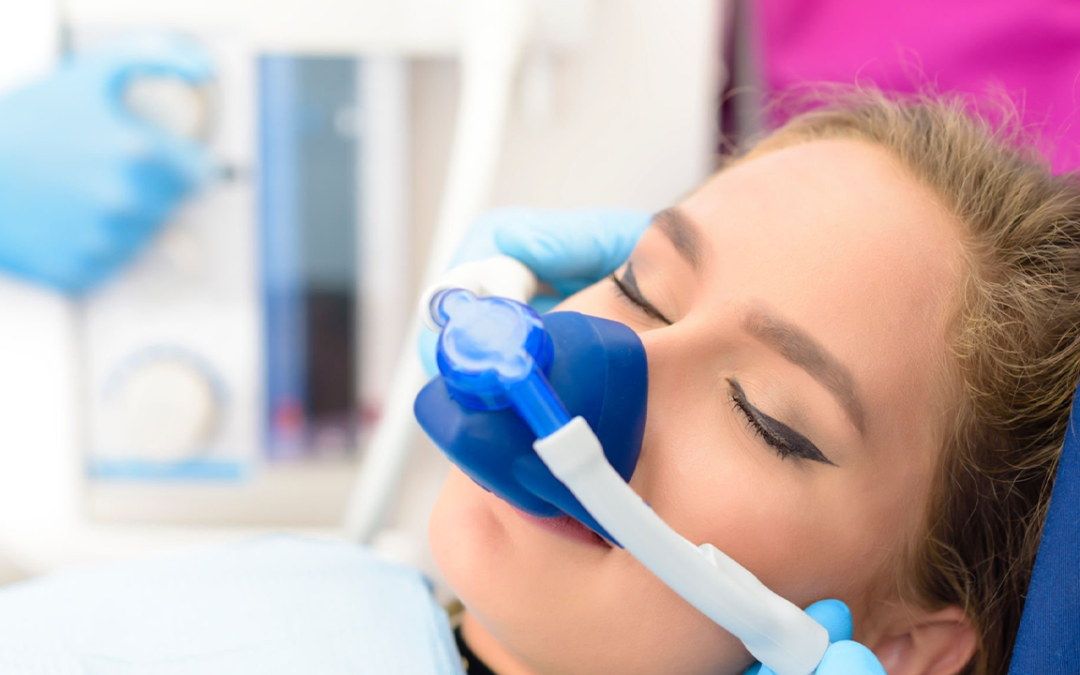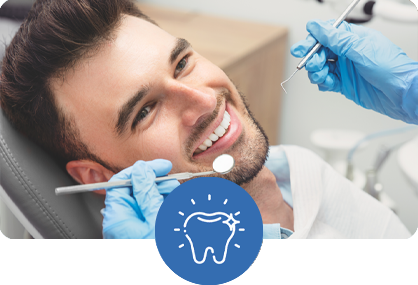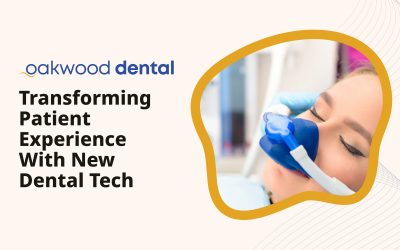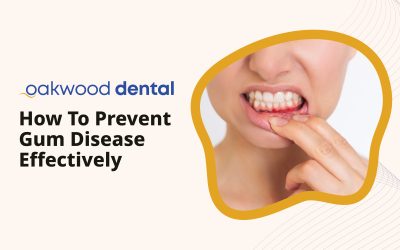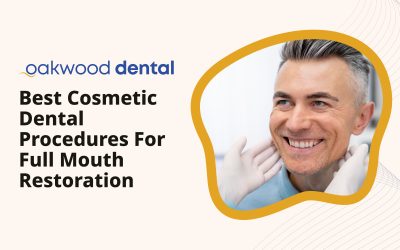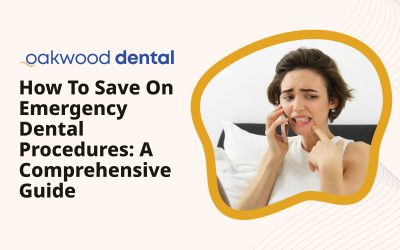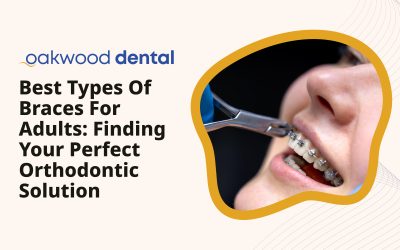Dental anxiety affects millions of people worldwide, preventing many from receiving necessary oral healthcare. For those who experience fear, stress, or panic at the thought of dental visits, sedation dentistry offers a practical solution that transforms the experience. At Oakwood Dental Clinics, we understand these concerns and provide compassionate care through various sedation options tailored to each patient’s specific needs and anxiety levels.
Key Takeaways About Sedation Dentistry
- Sedation dentistry offers multiple options including nitrous oxide, oral medication, and IV sedation to accommodate different anxiety levels
- Dental anxiety affects approximately 36% of Americans, with many avoiding essential care due to fear
- Sedation techniques help manage strong gag reflexes, reduce procedure memory, and enable longer treatment sessions
- Patients with special needs, severe anxiety, and those requiring complex procedures benefit most from sedation
- Modern sedation protocols include comprehensive pre-procedure evaluation and continuous monitoring for maximum safety
- Regular dental care through sedation therapy leads to improved long-term oral health and reduced anxiety over time
Introduction to Dental Anxiety and Sedation Solutions
Dental anxiety affects millions of people worldwide, preventing many from receiving necessary oral healthcare. For those who experience fear, stress, or panic at the thought of dental visits, sedation dentistry offers a practical solution that transforms the experience. At Oakwood Dental Clinics, we understand these concerns and provide compassionate care through various sedation options.
Dental anxiety isn’t simply a matter of being uncomfortable—it can lead to serious oral health consequences when patients avoid necessary treatments. According to research, approximately 36% of Americans experience some form of dental anxiety, with a significant portion avoiding dental care altogether due to these fears. This avoidance often creates a harmful cycle where minor dental issues develop into major problems requiring more invasive and costly interventions, further reinforcing anxiety about dental procedures.
Sedation dentistry represents a complete approach to managing dental anxiety, allowing patients to receive necessary care in a comfortable, stress-free environment. By understanding techniques to combat dental anxiety, patients can take the first step toward improved oral health without the overwhelming fear that has kept them away. Modern sedation techniques are designed to address various levels of anxiety, from mild nervousness to severe dental phobia, ensuring that virtually all patients can access the dental care they need regardless of their anxiety levels.
Types of Dental Sedation Techniques
Nitrous Oxide Sedation (Laughing Gas)
Nitrous oxide, commonly known as laughing gas, offers a mild form of sedation that helps patients relax while remaining fully conscious. This gas is mixed with oxygen and administered through a small mask placed over the nose. The effects begin quickly and wear off just as fast once the gas is turned off, typically within 3-5 minutes. This rapid onset and recovery make nitrous oxide one of the most convenient sedation options available in modern dentistry, particularly for patients with mild to moderate anxiety.
Nitrous oxide sedation is particularly beneficial for:
- Patients with mild to moderate anxiety who need just enough relaxation to comfortably undergo treatment
- Those undergoing routine dental procedures such as cleanings, fillings, or crown preparations
- Children and adults who need help relaxing but can generally cooperate with instructions
- Patients who want to drive themselves home after treatment without arranging transportation
The benefits of nitrous oxide include its fast-acting nature and the ability for patients to recover quickly. Most people can resume normal activities immediately after their appointment, making it a convenient option for busy individuals. Nitrous oxide creates a euphoric, relaxed feeling that helps reduce anxiety without causing unconsciousness, allowing patients to remain responsive and in control throughout their treatment while still experiencing significant anxiety relief.
IV Sedation
Intravenous (IV) sedation provides a deeper level of relaxation by administering sedative medications directly into the bloodstream. This technique allows for precise control of the sedation level throughout the procedure, as the dentist can adjust the medication dosage in real-time based on the patient’s response and the requirements of the procedure. IV sedation induces a state often described as “twilight sleep,” where patients remain technically conscious but experience profound relaxation and limited awareness of the dental procedure.
At Oakwood Dental Clinics, our IV sedation techniques include constant monitoring of vital signs to ensure patient safety throughout the procedure. This approach is particularly well-suited for:
- Patients with severe dental anxiety or phobia who cannot tolerate treatment even with milder forms of sedation
- Those undergoing lengthy or complex dental procedures that might require several hours to complete
- People with a strong gag reflex that interferes with dental treatment despite local anesthesia
- Individuals with special needs who may have difficulty remaining still for extended periods
IV sedation creates an experience where patients often have little to no memory of the procedure, despite technically remaining conscious. This amnesic effect helps patients with severe anxiety by eliminating traumatic memories associated with dental work. The medication-induced amnesia effectively breaks the cycle of dental fear by preventing new negative associations from forming during treatment, which can be particularly valuable for patients whose anxiety stems from previous traumatic dental experiences.
Oral Sedation
Oral sedation involves taking a prescribed medication before the dental appointment to induce a state of relaxation. Depending on the dosage, the effects can range from mild relaxation to moderate sedation where patients may even doze off during the procedure. Typically, patients take the medication about an hour before their scheduled appointment, allowing time for the sedative effects to develop fully. This method provides a middle ground between the mild effects of nitrous oxide and the deeper sedation achieved with IV administration.
This method is beneficial for patients who:
- Have moderate anxiety about dental procedures that nitrous oxide alone cannot adequately address
- Prefer not to use needles for sedation, making it an excellent alternative to IV sedation for needle-phobic patients
- Need longer treatments that require extended relaxation throughout complex procedures
- Want a simple approach to managing dental fears without the equipment associated with other sedation methods
The comprehensive sleep dentistry solutions we offer include customized oral sedation protocols based on each patient’s specific needs and medical history. The medications used are typically from the benzodiazepine family, which not only produces sedation but also has anxiolytic (anxiety-reducing) and amnesic properties. This combination of effects makes oral sedation particularly effective for anxious patients who benefit from reduced awareness and limited memory of their dental procedure.
Primary Benefits of Sedation Dentistry
Anxiety and Fear Reduction
One of the most significant advantages of sedation dentistry is its ability to alleviate anxiety and fear. For many patients, dental anxiety can be debilitating, preventing them from seeking necessary care. Sedation creates a calm, relaxed state that allows patients to receive treatment without the overwhelming stress they normally experience. This anxiety reduction works on multiple levels, addressing both the conscious fears and subconscious stress responses that can make dental visits so challenging for anxious patients.
By implementing strategies to combat dental anxiety, our team helps patients overcome their fears and develop healthier relationships with dental care. Many patients report that after experiencing sedation dentistry, their overall anxiety about future dental visits decreases significantly. This reduction in anxiety often occurs because sedation prevents the reinforcement of negative associations with dental treatment, effectively interrupting the cycle of fear that many anxious patients experience with each dental visit.
Comfort During Long Procedures
Dental procedures that require extended time in the chair can be physically and mentally taxing for patients. Sedation dentistry allows for greater comfort during these longer treatments by:
Sedation reduces awareness of time passing, making three-hour procedures feel like they lasted only minutes. It minimizes physical discomfort from maintaining the same position for extended periods, preventing muscle stiffness and pain. It decreases jaw fatigue from keeping the mouth open during lengthy procedures, which can be particularly uncomfortable. Sedation also allows dentists to complete multiple procedures in a single visit, reducing the total number of appointments needed.
This benefit is particularly valuable for patients undergoing comprehensive treatments or smile makeovers that would otherwise require numerous appointments. Our sedation dentistry services make these complex procedures more manageable for both patients and practitioners. For example, a full-mouth reconstruction that might normally require 6-8 separate visits could potentially be completed in just 2-3 longer appointments under sedation, significantly reducing the overall treatment time and stress for anxious patients.
Gag Reflex Management
Many patients have sensitive gag reflexes that can interfere with dental treatments, especially those involving the back of the mouth. This hypersensitive reflex can make even routine procedures like taking X-rays or impressions extremely difficult and uncomfortable. Sedation significantly reduces or eliminates this reflex, allowing for:
Sedation makes taking impressions for crowns, bridges, or dentures more comfortable, enabling accurate molds without triggering gagging. It provides easier access to rear molars for treatment, including fillings, crowns, and root canals in difficult-to-reach areas. There’s less interruption during procedures, improving efficiency and reducing appointment times. Patients also experience reduced anxiety about triggering the gag reflex, which often creates a cycle where anxiety worsens the gag response.
For patients who have avoided dental care due to a strong gag reflex, sedation dentistry opens the door to necessary treatments that were previously unbearable. The relaxation of throat muscles during sedation effectively suppresses the gag reflex, allowing dental professionals to work efficiently without causing patient discomfort or interrupting procedures repeatedly due to gagging episodes.
Memory Reduction of Dental Procedures
Many forms of sedation, particularly IV sedation, create an amnesic effect where patients have limited or no memory of the dental procedure. This beneficial side effect means that even though patients remain conscious during treatment, they typically recall very little about the sights, sounds, smells, or sensations experienced during their dental visit. This memory suppression is not just a convenient side effect but often a primary therapeutic goal for patients with severe dental anxiety.
By reducing or eliminating the formation of new negative memories associated with dental treatment, sedation helps break the cycle of dental anxiety. Patients can receive the care they need without adding to their psychological burden of dental fear. For individuals whose anxiety stems from traumatic past dental experiences, this amnesic effect prevents the creation of new traumatic memories that might otherwise reinforce and intensify their existing dental phobia, gradually allowing them to develop a healthier relationship with dental care.
Ideal Candidates for Dental Sedation
Patients with Dental Anxiety or Phobia
Dental anxiety ranges from mild nervousness to severe phobia that prevents patients from seeking necessary care. This anxiety spectrum affects a surprisingly large portion of the population, with some studies suggesting that up to 75% of adults experience some degree of dental anxiety, while 5-10% suffer from dental phobia severe enough to be considered a true psychological condition. Sedation dentistry is particularly beneficial for those who:
Many people experience physical symptoms of anxiety (racing heart, sweating, trembling) at dental appointments or even when thinking about dental visits. Some have postponed or avoided dental care due to fear, sometimes for years or even decades, leading to poor oral health. Others feel extreme stress about specific aspects of dental visits (sounds, smells, needles, drills) that trigger anxiety responses. Many patients have had traumatic dental experiences in the past that continue to affect their ability to receive dental care.
At Oakwood Dental Clinics, we take a compassionate approach to helping anxious patients receive the care they need through appropriate sedation techniques tailored to their level of anxiety. We recognize that dental anxiety exists on a spectrum, and our sedation options are customized accordingly, from mild nitrous oxide for those with moderate nervousness to deep IV sedation for patients with severe dental phobia who cannot tolerate treatment any other way.
Patients Requiring Extensive Dental Work
Individuals needing complex or multiple procedures can benefit significantly from sedation dentistry. These patients often face hours of treatment that would be physically and emotionally exhausting without sedation assistance. The ability to complete multiple procedures in fewer, longer appointments under sedation can dramatically improve the treatment experience and efficiency for these patients. These complex treatments may include:
- Full-mouth reconstructions involving multiple crowns, bridges, or implants to restore severely damaged dentition
- Multiple extractions, such as wisdom teeth removal or preparation for dentures or implant-supported prosthetics
- Extensive cosmetic procedures including veneer placement, crown lengthening, and comprehensive smile makeovers
- Implant placements, especially when multiple implants are being placed in a single surgical session
- Root canal treatments on several teeth, particularly molars that may require more time and precision
For these patients, sedation allows dentists to complete more work in fewer appointments, reducing the overall time and stress associated with dental treatment. Our team at Oakwood Dental Clinics specializes in dental implant procedures under sedation, making this advanced tooth replacement option accessible even to anxious patients. The efficiency of completing multiple procedures in a single sedated visit also often reduces the total treatment cost and recovery time compared to numerous separate appointments.
Patients with Special Healthcare Needs
Sedation dentistry plays a crucial role in providing dental care to patients with special healthcare needs who might otherwise struggle to receive treatment. For these individuals, traditional dental appointments can present insurmountable challenges that sedation can effectively address. The controlled environment created through sedation allows for safe, comprehensive care that might otherwise be impossible to deliver.
This includes patients with:
- Intellectual or developmental disabilities that affect comprehension or cooperation during dental procedures
- Sensory processing disorders that make the sights, sounds, and sensations of dental treatment overwhelming
- Movement disorders that make it difficult to remain still during precise dental work, such as cerebral palsy or Parkinson’s disease
- Autism spectrum disorders that can make the dental environment challenging due to sensory sensitivities and routine disruption
- Alzheimer’s disease or dementia that may cause confusion or agitation during dental treatment
Our dental sedation for special needs services help these individuals receive comprehensive dental care in a safe, controlled environment. By using dental sedation for special needs patients, we can provide essential treatments that might otherwise be inaccessible. Our approach involves collaboration with caregivers, physicians, and specialists to develop individualized treatment plans that address each patient’s unique challenges while ensuring their comfort and dignity throughout the dental care process.
Patients with Low Pain Thresholds
Some individuals naturally experience greater sensitivity to pain or discomfort during dental procedures. For these patients, even with local anesthesia, dental work can be particularly uncomfortable. This heightened sensitivity may be due to genetic factors, previous traumatic experiences that have lowered pain tolerance, or conditions like fibromyalgia that affect how pain signals are processed by the nervous system. Sedation provides an additional layer of comfort by:
Sedation reduces overall sensory perception, creating a buffer between the patient and potentially uncomfortable sensations. It decreases anxiety that can lower pain thresholds, as fear and anticipation often amplify pain perception. Sedation creates a relaxed state that minimizes discomfort, allowing muscles to remain loose rather than tensed in anticipation. It also allows for adequate local anesthesia without anxiety, as some patients with dental fear resist getting fully numb due to fear of injections.
Our team takes care to assess each patient’s specific needs and concerns, creating personalized sedation plans that address individual pain sensitivity levels. For patients with documented low pain thresholds, sedation can transform dental treatment from an unbearable ordeal into a manageable experience, enabling them to receive necessary care without the extreme discomfort they might otherwise experience even with standard pain management techniques.
Safety Protocols and Patient Monitoring
Pre-Procedure Evaluation
Before administering any form of sedation, a thorough evaluation is essential to ensure patient safety. This comprehensive assessment helps identify potential risk factors and determines the most appropriate sedation approach for each individual. At Oakwood Dental Clinics, this evaluation includes:
- Comprehensive medical history review, including past surgeries, hospitalizations, and reactions to anesthesia or sedation
- Assessment of current medications, including prescription drugs, over-the-counter medications, and supplements that might interact with sedatives
- Evaluation of any allergies or previous adverse reactions to medications, particularly those related to sedatives or anesthetics
- Discussion of sedation options appropriate for the patient’s health status, anxiety level, and planned procedures
- Clear pre-procedure instructions regarding fasting requirements, medication adjustments, and transportation arrangements
This careful screening process helps identify any potential risks and determines the most appropriate sedation method for each individual. Our emergency dental care team is also trained in sedation protocols to handle urgent situations safely. The evaluation may include baseline vital signs, airway assessment, and in some cases, consultation with the patient’s primary care physician to ensure that sedation can be administered safely given any existing medical conditions.
Continuous Monitoring During Procedures
Throughout sedation procedures, patient safety remains the top priority. Modern sedation dentistry incorporates sophisticated monitoring techniques that were once found only in hospital settings, bringing hospital-level safety standards into the dental office. Our dental professionals use advanced monitoring equipment to track:
We monitor blood pressure at regular intervals throughout the procedure to ensure cardiovascular stability. We track heart rate and rhythm through continuous electrocardiogram (ECG) monitoring for deeper sedation levels. We check oxygen saturation levels via pulse oximetry, providing real-time data on how effectively oxygen is being delivered to tissues. We monitor respiratory rate and pattern to ensure adequate ventilation and prevent respiratory depression. We also assess level of consciousness through regular verbal or tactile stimulation appropriate to the sedation depth.
This continuous monitoring allows for immediate adjustments to sedation levels if needed and ensures the patient remains stable throughout treatment. Our team is certified in advanced life support and prepared to respond to any unexpected situations. For deeper levels of sedation, we often employ a dedicated monitoring professional whose sole responsibility is to observe the patient’s vital signs and level of sedation, allowing the dentist to focus entirely on the dental procedure while maintaining optimal patient safety.
Post-Procedure Care and Recovery
After sedation dentistry, proper recovery protocols are essential for patient safety. The recovery process is carefully managed to ensure patients return to full awareness and function before leaving the office, with protocols tailored to the specific type and depth of sedation used. These comprehensive recovery procedures include:
- Monitored recovery time in the office, with continued observation of vital signs until discharge criteria are met
- Clear discharge criteria that must be met before leaving, including stable vital signs, adequate responsiveness, and ability to ambulate safely
- Written post-procedure instructions covering activity restrictions, dietary guidelines, and potential side effects to watch for
- Required escort for moderate to deep sedation patients, with verification that a responsible adult is present to transport the patient home
- Follow-up contact to check on recovery, typically within 24 hours of the procedure, to address any concerns or questions
Patients receiving endodontic treatment under sedation benefit from these careful recovery protocols, ensuring they transition safely from the sedated state back to full awareness. For procedures like root canals that may involve deeper sedation due to their length or complexity, these recovery protocols are particularly important to ensure patients can safely manage post-procedure discomfort and follow necessary care instructions after leaving the office.
Special Applications of Sedation Dentistry
Sedation for Children’s Dentistry
Children with dental anxiety or those requiring extensive treatment can benefit significantly from appropriate sedation techniques. Pediatric dental sedation requires specialized knowledge and training due to children’s unique physiological responses to sedative medications and their developmental stages. At Oakwood Dental Clinics, pediatric sedation is carefully tailored to:
We consider the child’s age, weight, and health status, with medication dosages precisely calculated based on these factors. We match the complexity and duration of the needed treatment with appropriate sedation depth. We take into account the child’s temperament and anxiety level, considering their emotional development and previous experiences. We also consider previous dental experiences, especially any negative encounters that might contribute to dental fear.
Mild sedation options like nitrous oxide are often sufficient for children with mild anxiety, while more complex cases may require deeper sedation administered by specialists trained in pediatric sedation. Parents receive comprehensive guidance on preparing their child for the appointment and managing recovery. This preparation includes clear instructions about pre-appointment fasting requirements, what to expect during the visit, and how to support their child through the recovery process, creating a team approach between dental professionals and parents.
Sedation for Patients with Special Needs
Providing dental care to patients with special needs presents unique challenges that sedation dentistry can help address. For these individuals, traditional dental environments and procedures can be overwhelming or impossible to tolerate due to their specific conditions. Sedation creates an environment where necessary dental care becomes accessible and manageable. These patients may include individuals with:
- Physical limitations that make traditional dental positioning difficult, requiring adaptations for comfort and access
- Cognitive impairments affecting cooperation or understanding, where explaining procedures may not be sufficient
- Sensory sensitivities that make the dental environment overwhelming, including reactions to lights, sounds, or tactile stimulation
- Communication difficulties that complicate treatment, making it challenging to express discomfort or understand instructions
Our approach to dental sedation for special needs patients involves close collaboration with caregivers and other healthcare providers to create individualized treatment plans. This specialized care helps ensure that all patients, regardless of their challenges, can access essential dental services. For many special needs patients, sedation dentistry represents the difference between receiving comprehensive oral healthcare and suffering from untreated dental disease that can significantly impact their overall health and quality of life.
Sedation for Complex Dental Procedures
Certain advanced dental procedures benefit particularly from sedation techniques due to their complexity, duration, or invasive nature. These complex procedures often require precise, uninterrupted work by the dentist and would be difficult for patients to tolerate comfortably without sedation assistance. The controlled environment created through sedation allows for optimal surgical conditions and patient comfort during these demanding procedures. These may include:
- Full-mouth reconstructions involving multiple restorative procedures to completely rehabilitate a patient’s dentition
- Multiple implant placements, particularly for procedures like All-on-4 or All-on-6 implant-supported dentures
- Bone grafting procedures that prepare the jaw for future implant placement by rebuilding lost bone volume
- Extensive periodontal surgery to address advanced gum disease, including tissue grafts and pocket reduction
- Wisdom tooth extractions, especially impacted teeth requiring significant surgical intervention
For patients undergoing dental implant procedures, sedation not only provides comfort but also creates optimal conditions for the dentist to work with precision. This is particularly important for procedures that require absolute stillness for extended periods. The controlled environment allows for careful attention to detail during these technically demanding procedures, potentially improving surgical outcomes while simultaneously enhancing the patient experience through comfort and anxiety control.
Addressing Common Concerns About Dental Sedation
Is Sedation Dentistry Safe?
Safety is the foremost concern for patients considering sedation dentistry. Modern dental sedation techniques have evolved significantly over the past decades, incorporating advanced monitoring technologies and standardized protocols that have dramatically improved safety profiles. At Oakwood Dental Clinics, we maintain the highest safety standards by:
- Using only FDA-approved medications administered by qualified professionals with specialized training in dental sedation techniques
- Conducting thorough pre-sedation evaluations to identify risk factors and contraindications before any sedation is administered
- Employing continuous monitoring throughout procedures using hospital-grade equipment to track vital signs in real-time
- Maintaining appropriate emergency equipment and medications in the office, ready for immediate use if needed
- Ensuring all sedation providers have advanced training and certification, including regular updates on the latest safety protocols
When administered by properly trained professionals following established protocols, dental sedation has an excellent safety record. The risk of complications is minimized through careful patient screening and monitoring. Statistical data supports this safety profile, with serious adverse events being extremely rare when proper protocols are followed. The American Dental Association and other regulatory bodies provide strict guidelines for sedation administration that our practice follows meticulously.
What Does Sedation Feel Like?
Many patients are curious about the subjective experience of dental sedation. Understanding what to expect can help alleviate concerns about the unknown aspects of sedation. While individual experiences vary based on the type and level of sedation, most patients report remarkably similar sensations that contribute to a positive dental experience. Typically, patients describe:
Patients experience a feeling of deep relaxation and calmness that develops gradually as the sedation takes effect, replacing anxiety with tranquility. They have reduced awareness of surroundings and procedures, creating a detached feeling where dental work happens “in the background.” There’s a sense of time passing quickly, with procedures that take hours seeming to last only minutes from the patient’s perspective. Patients often have little to no memory of the dental work itself, particularly with deeper forms of sedation that produce an amnesic effect. They don’t feel “completely unconscious” (except with general anesthesia), but rather experience a dreamlike, detached state.
Relaxation
Patients experience a calm, peaceful state throughout their procedure
Time Perception
Procedures seem to take much less time than they actually do
Memory Effect
Limited or no memory of the dental work performed
Consciousness
Able to respond to instructions while feeling detached from procedures
Many patients describe the experience as “being awake but not caring” about the dental work being performed. This detached awareness allows patients to cooperate with instructions while remaining comfortable and anxiety-free. Patients often report being able to respond to the dentist’s requests, such as opening wider or turning their head, while feeling completely removed from any stress or discomfort that would normally accompany the procedure. This combination of cooperation and comfort makes sedation dentistry particularly effective.
Recovery After Sedation
The recovery process varies depending on the type of sedation received, and understanding these differences helps patients plan appropriately for their appointments. Each sedation method has distinct recovery characteristics that affect post-appointment activities and requirements. Patients should be aware of these differences when scheduling their treatment:
With nitrous oxide, effects disappear within minutes after the gas is turned off, allowing patients to drive themselves home and resume normal activities immediately. This quick recovery makes nitrous oxide perfect for patients who need to return to work or other responsibilities right after their appointment. With oral sedation, effects may last several hours, requiring someone to drive the patient home and supervision for the rest of the day. Patients typically experience a gradual return to normal alertness over 4-6 hours but may feel drowsy for longer. With IV sedation, recovery typically takes several hours, with some grogginess potentially lasting into the next day. Patients need an escort and should not drive, work, or make important decisions for 24 hours. The deeper the sedation, the longer the recovery period typically lasts.
Our team provides detailed post-procedure care instructions tailored to each patient’s specific situation and sedation type. These instructions include guidance on activity restrictions, dietary recommendations, and when to resume normal medications. We also provide emergency contact information and schedule follow-up communications to ensure patients are recovering as expected.
Long-Term Benefits of Sedation Dentistry
Improved Oral Health Through Regular Care
Perhaps the most significant long-term benefit of sedation dentistry is that it enables anxious patients to receive regular dental care. For individuals whose anxiety previously prevented them from seeking treatment, sedation opens the door to consistent, preventive dental visits that can dramatically improve oral health outcomes. This consistent care leads to:
- Earlier detection and treatment of dental problems before they develop into painful, expensive emergencies requiring invasive procedures
- Prevention of advanced dental disease through regular professional cleanings and examinations that remove plaque and detect early signs of decay
- Reduced need for emergency dental interventions, which are often more traumatic and reinforce dental anxiety
- Better overall oral health outcomes, including reduced incidence of tooth loss, periodontal disease, and chronic oral infections
- Lower lifetime dental costs through preventive care that addresses issues before they require extensive, expensive treatments
By making dental visits manageable for anxious patients, sedation dentistry helps break the cycle of avoidance and emergency care that often characterizes dental phobia. Many patients who begin with sedation for all procedures eventually find they need less sedation over time as their anxiety decreases through positive experiences, ultimately transitioning to routine care with minimal or no sedation for regular preventive visits.
Changing Perceptions of Dental Experiences
Many patients find that positive experiences with sedation dentistry gradually change their perception of dental care. This psychological shift represents one of the most profound benefits of sedation dentistry, as it can transform a patient’s relationship with dental care from one dominated by fear to one characterized by manageable comfort. Over time, this can lead to:
Patients experience decreased anxiety about future dental visits as they accumulate positive experiences that contradict their previous negative associations. They show increased willingness to undergo necessary treatments rather than postponing care until problems become severe. They develop more positive associations with dental care, replacing fear-based memories with neutral or positive experiences. Many patients experience a potential reduction in sedation needs for future appointments as anxiety decreases, allowing them to transition to lighter forms of sedation. They also develop better communication with dental providers as fear no longer prevents them from discussing concerns and asking questions.
This psychological shift can be profound, allowing patients to consider cosmetic dental treatments and professional whitening options they would never have contemplated while in the grip of dental anxiety. Many patients who initially sought sedation dentistry simply to address urgent dental problems eventually become interested in elective cosmetic procedures as their fear diminishes and they recognize the potential benefits of aesthetic dental improvements.
Enhanced Quality of Life
The ripple effects of addressing dental anxiety through sedation extend beyond oral health to overall quality of life. Dental problems can significantly impact daily functioning, social interactions, and self-perception, and resolving these issues through sedation dentistry can create substantial improvements in multiple aspects of a patient’s life. These quality-of-life enhancements include:
- Elimination of chronic pain from untreated dental conditions, which can interfere with sleep, concentration, work performance, and mood
- Improved self-confidence from addressing dental aesthetic concerns that may have caused social embarrassment or self-consciousness
- Reduced general anxiety related to dental problems, eliminating the constant worry about dental pain or emergencies
- Better nutrition through improved chewing function, allowing patients to enjoy a wider variety of healthy foods that were previously difficult to eat
- Enhanced social interactions without dental-related embarrassment from issues like missing teeth, visible decay, or chronic bad breath
These quality-of-life improvements represent the true value of sedation dentistry for many patients who have struggled with dental anxiety. By addressing both the physical and psychological aspects of dental health, sedation dentistry helps patients achieve not just better oral health but also improved overall wellbeing and social functioning. The confidence that comes from resolving long-standing dental issues can positively impact personal relationships, professional opportunities, and daily comfort in profound ways.
Conclusion
Sedation dentistry has transformed the dental experience for countless anxious patients, making necessary oral healthcare accessible and comfortable. At Oakwood Dental Clinics, we’re committed to providing these valuable services with the highest standards of safety and patient care. Through our comprehensive approach to sedation options, we’ve helped patients overcome decades of dental fear and avoidance to achieve healthy, functional, and attractive smiles.
For patients with dental anxiety, sedation options offer a pathway to improved oral health without the emotional distress traditionally associated with dental visits. From mild relaxation with nitrous oxide to deeper sedation for complex procedures, these techniques can be tailored to individual needs and concerns. This personalized approach ensures that each patient receives exactly the level of sedation needed to make their specific dental experience comfortable and stress-free.
The benefits extend far beyond the immediate comfort during procedures—sedation dentistry helps patients establish healthier relationships with dental care, leading to better long-term oral health outcomes and enhanced quality of life. By addressing the psychological barriers to dental treatment, sedation dentistry plays a crucial role in comprehensive healthcare. For many patients, the ability to receive dental care without anxiety represents a life-changing improvement that affects not just their oral health but their overall wellbeing and confidence.

 718-979-2121
718-979-2121